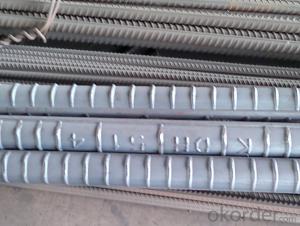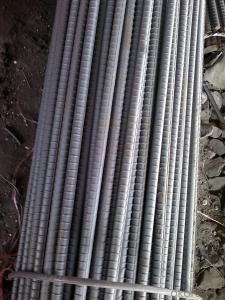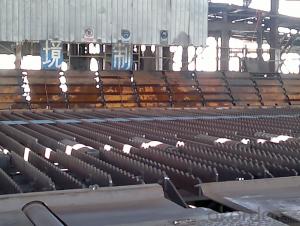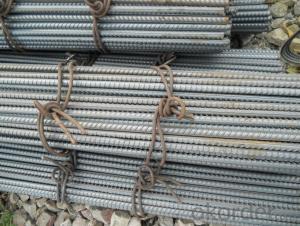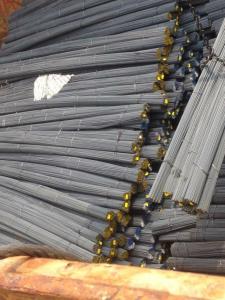Deformed Steel Bar HRB400
- Loading Port:
- China Main Port
- Payment Terms:
- TT or LC
- Min Order Qty:
- -
- Supply Capability:
- -
OKorder Service Pledge
OKorder Financial Service
You Might Also Like
Product Description:
OKorder is offering Deformed Steel Bar HRB400 at great prices with worldwide shipping. Our supplier is a world-class manufacturer of steel, with our products utilized the world over. OKorder annually supplies products to European, North American and Asian markets. We provide quotations within 24 hours of receiving an inquiry and guarantee competitive prices.
Standard | GB | HRB400 | |
Diameter | 6mm,8mm,10mm,12mm,14mm,16mm,18mm,20mm, 22mm,25mm,28mm,32mm,36mm,40mm,50mm | ||
Length | 6M, 9M,12M or as required | ||
Place of origin | Hebei, China mainland | ||
Advantages | exact size, regular package, chemical and mechanical properties are stable. | ||
Type | Hot rolled deformed steel bar | ||
Brand name | DRAGON | ||
Chemical Composition: (Please kindly find our chemistry of our material based on HRB500 as below for your information)
Grade | Technical data of the original chemical composition (%) | ||||||
C | Mn | Si | S | P | V | ||
HRB400 | ≤0.25 | ≤1.60 | ≤0.80 | ≤0.045 | ≤0.045 | 0.04-0.12 | |
Physical capability | |||||||
Yield Strength (N/cm²) | Tensile Strength (N/cm²) | Elongation (%) | |||||
≥400 | ≥570 | ≥14 | |||||
Theoretical weight and section area of each diameter as below for your information:
Diameter(mm) | Section area (mm²) | Mass(kg/m) | Weight of 12m bar(kg) |
6 | 28.27 | 0.222 | 2.664 |
8 | 50.27 | 0.395 | 4.74 |
10 | 78.54 | 0.617 | 7.404 |
12 | 113.1 | 0.888 | 10.656 |
14 | 153.9 | 1.21 | 14.52 |
16 | 201.1 | 1.58 | 18.96 |
18 | 254.5 | 2.00 | 24 |
20 | 314.2 | 2.47 | 29.64 |
22 | 380.1 | 2.98 | 35.76 |
25 | 490.9 | 3.85 | 46.2 |
28 | 615.8 | 4.83 | 57.96 |
32 | 804.2 | 6.31 | 75.72 |
36 | 1018 | 7.99 | 98.88 |
40 | 1257 | 9.87 | 118.44 |
50 | 1964 | 15.42 | 185.04 |
Deformed bar is widely used in buildings, bridges, roads and other engineering construction. Big to highways, railways, bridges, culverts, tunnels, public facilities such as flood control, dam, small to housing construction, beam, column, wall and the foundation of the plate, deformed bar is an integral structure material. With the development of world economy and the vigorous development of infrastructure construction, real estate, the demand for deformed bar will be larger and larger..
Packaging Detail: products are packed in bundle and then shipped by container or bulk vessel, deformed bar is usually naked strapping delivery, when storing, please pay attention to moisture proof. The performance of rust will produce adverse effect.
Each bundle weight: 2-3MT, or as required
Product Applications:
Deformed Steel Bar HRB400 are ideal for structural applications and are widely used in the construction of buildings and bridges, and the manufacturing, petrochemical, and transportation industries.
Product Advantages:
OKorder's Deformed Steel Bar HRB400 are durable, strong, and resist corrosion.
Main Product Features:
· Premium quality
· Prompt delivery & seaworthy packing (30 days after receiving deposit)
· Corrosion resistance
· Can be recycled and reused
· Mill test certification
Product Specifications:
Standard: GB
Material: Q235
Origin place: China
FAQ:
Q1: Can stainless steel rust?
A1: Stainless does not "rust" as you think of regular steel rusting with a red oxide on the surface that flakes off. If you see red rust it is probably due to some iron particles that have contaminated the surface of the stainless steel and it is these iron particles that are rusting. Look at the source of the rusting and see if you can remove it from the surface.
Q2: How do we guarantee the quality of our products?
A2: We have established an advanced quality management system which conducts strict quality tests at every step, from raw materials to the final product. At the same time, we provide extensive follow-up service assurances as required.
Q3: How soon can we receive the product after purchase?
A3: Within three days of placing an order, we will begin production. The specific shipping date is dependent upon international and government factors, but is typically 7 to 10 workdays.
bdenum enhance this surface layer and improve the corrosion resistance of the stainless material.
Images:

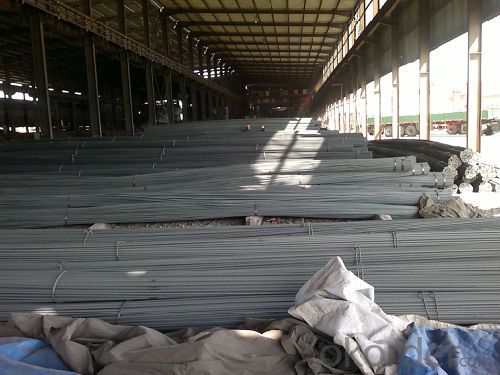
- Q:Are steel rebars suitable for use in structures with high resistance to impact?
- Structures with high resistance to impact can generally make use of steel rebars. These rebars, also known as reinforcement bars, are made from steel and are commonly utilized in concrete structures to enhance their strength and durability. Steel possesses high tensile strength and the ability to absorb and distribute impact forces, making it an excellent material for reinforcement. In situations where impact is a concern, like in bridges, highways, or buildings located in earthquake-prone areas, steel rebars perform a critical function by providing additional strength and resistance. By incorporating rebars, the structure becomes capable of withstanding sudden impact loads and preventing catastrophic failures. Furthermore, engineers have the option to choose from various grades and sizes of steel rebars, ensuring that the appropriate type is selected based on the specific requirements of the structure. Higher grade rebars, such as Grade 60 or Grade 75, offer increased strength and ductility, making them particularly suitable for structures with high resistance to impact. It is worth noting that while steel rebars enhance the overall strength and impact resistance of a structure, other factors such as design, construction techniques, and maintenance also play significant roles in ensuring the structure's ability to withstand impact forces. Therefore, taking a comprehensive approach that encompasses all these factors is crucial when designing and constructing structures with high resistance to impact.
- Q:What are the guidelines for repairing damaged steel rebars in a structure?
- When it comes to repairing damaged steel rebars in a structure, there are several guidelines that need to be followed to ensure the structural integrity of the building. Here are some key guidelines: 1. Inspection: Before starting the repair process, a thorough inspection of the damaged rebars should be conducted. This includes assessing the extent of the damage, identifying the cause of the damage, and determining whether repair is feasible or if replacement is required. 2. Cleaning: The damaged rebars need to be cleaned properly to remove any loose rust, scale, or other contaminants. This can be done using wire brushes, sandblasting, or other appropriate cleaning methods. 3. Removal of damaged material: Any corroded or severely damaged portions of the rebars should be removed. This may involve cutting out the damaged area and replacing it with a new rebar, or using techniques such as welding or epoxy bonding to repair the damaged section. 4. Surface preparation: The surface of the rebars should be prepared to ensure proper adhesion of the repair material. This may involve roughening the surface, applying a bonding agent, or using other surface preparation techniques depending on the specific repair method being employed. 5. Repair material selection: The choice of repair material will depend on factors such as the severity of the damage, the load-bearing capacity required, and the environment in which the rebars are located. Common repair materials include epoxy resins, cementitious mortars, or other specialized repair products. 6. Repair technique: The repair technique chosen should be appropriate for the specific damage and should comply with relevant industry standards and codes. Techniques such as welding, epoxy bonding, or mechanical splicing can be used to repair damaged rebars. 7. Quality control: Throughout the repair process, quality control measures should be implemented to ensure the effectiveness and durability of the repair. This may involve testing the repaired rebars for strength, monitoring the curing process, and conducting inspections to verify that the repairs have been carried out in accordance with the guidelines. 8. Documentation: It is essential to maintain thorough documentation of the repair process, including photographs, test results, and any relevant certifications or warranties. This documentation can be useful for future reference, maintenance, and to provide evidence of the repair work done. It is important to note that the guidelines for repairing damaged steel rebars may vary depending on the specific requirements of each project, local building codes, and the recommendations of structural engineers or repair specialists. Therefore, it is crucial to consult with experts in the field to ensure that the repair work is carried out safely and effectively.
- Q:What grade of reinforcement is used for cast-in-place floorslab?
- Now the more commonly used high-rise buildings are cast-in-place floorslab.The floor slab, of course, separates the floor and bears and transmits the floor load. At the same time, heat insulation, sound insulation, waterproof and so on.
- Q:How do steel rebars affect the overall lifespan of bridge structures?
- Steel rebars play a crucial role in enhancing the overall lifespan of bridge structures. By reinforcing concrete, rebars increase the tensile strength and structural integrity of the bridge, enabling it to bear heavy loads and withstand various environmental factors such as wind, earthquakes, and temperature fluctuations. This reinforcement prevents cracking, corrosion, and premature failure of the structure, ultimately extending its lifespan and ensuring the safety and reliability of the bridge for an extended period of time.
- Q:What are the main uses of steel rebars?
- Steel rebars, otherwise known as reinforcing bars, serve as a crucial component in construction and civil engineering endeavors, granting robustness and steadiness to concrete structures. The primary applications of steel rebars encompass the following: 1. Reinforcement of Concrete: Steel rebars are strategically integrated within concrete structures to heighten their tensile strength. While concrete exhibits commendable resistance against compressive forces, it remains vulnerable in terms of tension. By incorporating rebars, the resulting composite material (reinforced concrete) is endowed with the ability to withstand both compressive and tensile forces, rendering it suitable for various applications such as building columns, beams, slabs, and foundations. 2. Enhancement of Structural Stability: Steel rebars play a pivotal role in elevating the structural stability of edifices and infrastructures. They facilitate the uniform distribution of loads across the structure, preventing the occurrence of cracks, sagging, or collapse. Through the reinforcement of concrete elements with rebars, structures become capable of enduring substantial loads, seismic activity, and other external forces. 3. Bridges and Highways: Steel rebars find extensive employment in the construction of bridges and highways. As bridges are routinely subjected to substantial loads and harsh environmental conditions, robust and durable reinforcement is imperative. Steel rebars ensure the longevity and structural integrity of these critical infrastructure projects. 4. Retaining Walls and Tunnels: Retaining walls serve the purpose of holding back soil or other substances, thereby preventing erosion. Steel rebars are commonly employed to reinforce these structures, enabling them to withstand the lateral pressures exerted by the retained material. Similarly, in tunnel construction, rebars bestow strength upon the concrete lining, ensuring stability and averting collapse. 5. Foundations: Steel rebars form an indispensable constituent in the construction of building foundations. They contribute to the even distribution of the structure's weight onto the ground, thereby averting the occurrence of settlement or sinking. Furthermore, rebars anchor the foundation to the ground, endowing it with stability against soil movement or seismic forces. 6. Pre-stressed and Post-tensioned Concrete: In the realm of pre-stressed and post-tensioned concrete construction, steel rebars are employed to introduce compressive forces into the concrete members. This technique elevates the structural performance by diminishing tensile stress, augmenting load-bearing capacity, and minimizing cracking. 7. Masonry Reinforcement: Steel rebars are also utilized to reinforce masonry structures such as walls, columns, and arches. By embedding rebars within mortar joints or cores, the overall strength and stability of the masonry system are enhanced, enabling it to withstand lateral loads and seismic forces. To summarize, steel rebars are indispensable in contemporary construction endeavors, furnishing concrete structures with strength, stability, and durability. By virtue of their capacity to resist tensile forces, they ensure the well-being and longevity of buildings, bridges, highways, tunnels, and other crucial infrastructure projects.
- Q:Can steel rebars be used in reinforced masonry structures?
- Reinforced masonry structures can indeed utilize steel rebars to strengthen and provide structural integrity. These rebars, known as reinforcement bars, are commonly employed to fortify masonry elements such as walls, columns, and beams. They are inserted into the masonry units and then embedded in mortar or grout, establishing a robust connection between the steel and the masonry. The utilization of steel rebars in reinforced masonry structures presents various benefits. Firstly, it amplifies the load-bearing capacity of the structure, enabling it to withstand heavier loads and resist deformation. This is particularly crucial in regions susceptible to seismic activity or strong wind loads. Secondly, the steel rebars facilitate the even distribution of stress throughout the structure, averting localized failures and enhancing overall durability. Additionally, employing rebars can enhance the crack resistance of masonry, diminishing the risk of cracks and augmenting structural performance. It is important to note that the design and installation of steel rebars in reinforced masonry structures must adhere to specific codes and standards to ensure adequate safety and performance. The size, spacing, and placement of the rebars are determined based on structural calculations and engineering principles. Sufficient masonry coverage around the rebars is also vital to prevent corrosion and maintain long-term structural integrity. In conclusion, steel rebars are certainly suitable for enhancing the strength, load-bearing capacity, and durability of reinforced masonry structures. Proper design, installation, and adherence to building codes are essential to ensure the successful integration of rebars with masonry.
- Q:How do steel rebars affect the overall fire resistance of concrete structures?
- The overall fire resistance of concrete structures is greatly affected by steel rebars. These reinforcement bars, also known as steel rebars, are utilized in concrete structures to provide strength and stability. Their behavior when exposed to fire can either improve or weaken the fire resistance of the concrete structure. The fire resistance of the structure benefits from the inclusion of steel rebars. Steel's high thermal conductivity aids in dissipating the heat produced during a fire, preventing localized overheating and reducing the risk of structural failure. This dispersal of heat through the steel rebars slows down the rate at which the concrete's temperature rises, allowing for more time to evacuate and fight the fire. Furthermore, the presence of steel rebars also helps maintain the structural integrity of the concrete during a fire. Concrete has low tensile strength, and when subjected to high temperatures, it tends to crack and spall. However, the presence of steel rebars mitigates this issue by acting as reinforcement, holding the concrete together and preventing it from disintegrating due to heat. However, it is important to note that steel rebars can have a negative impact on fire resistance if not designed or protected properly. Insufficient size and spacing of the rebars can lead to a rapid transfer of heat through the concrete, resulting in premature failure. Additionally, if the rebars are not adequately protected with fire-resistant materials, they can lose their strength and integrity, further compromising the overall fire resistance of the structure. To ensure optimal fire resistance, designers and engineers consider various factors such as the size, spacing, and coating of the steel rebars, as well as the thickness of the concrete cover. Additionally, fireproofing measures such as using intumescent coatings, fire-resistant insulation, and fireproof claddings can be implemented to enhance the fire resistance of steel rebars and the overall concrete structure. In conclusion, steel rebars play a vital role in the fire resistance of concrete structures. When appropriately designed and protected, they enhance fire resistance by dissipating heat and maintaining structural integrity. However, inadequate design or lack of protection can compromise fire resistance. Therefore, it is crucial to adhere to proper design guidelines and implement appropriate fireproofing measures to ensure the overall fire safety of concrete structures.
- Q:Can steel rebars be used in precast concrete walls?
- Yes, steel rebars can be used in precast concrete walls. The presence of rebars helps to reinforce the concrete and increase its strength and durability. Rebars are commonly used in precast concrete walls to provide structural integrity and resist the forces acting on the wall.
- Q:What are the factors to consider while selecting steel rebars for a project?
- When selecting steel rebars for a project, there are several factors that need to be considered. Firstly, the grade of the steel rebar is important as it indicates the strength and durability of the material. The specific requirements of the project, such as structural load capacity and corrosion resistance, should also be taken into account. Another factor to consider is the size and shape of the rebars, as they need to be compatible with the design and construction techniques being used. Additionally, the supplier's reputation, certifications, and quality control processes should be considered to ensure the reliability and consistency of the steel rebars.
- Q:What are the guidelines for the proper spacing of steel rebars in columns?
- The guidelines for the proper spacing of steel rebars in columns typically depend on the specific design requirements and structural code regulations. However, common recommendations suggest placing rebars at a minimum distance of three times the diameter of the largest bar or 1.5 times the diameter of the smallest bar. This spacing ensures adequate concrete cover and allows for proper consolidation and strength development. It is crucial to consult the structural engineer or refer to the applicable building codes for precise guidelines.
1. Manufacturer Overview |
|
|---|---|
| Location | |
| Year Established | |
| Annual Output Value | |
| Main Markets | |
| Company Certifications | |
2. Manufacturer Certificates |
|
|---|---|
| a) Certification Name | |
| Range | |
| Reference | |
| Validity Period | |
3. Manufacturer Capability |
|
|---|---|
| a)Trade Capacity | |
| Nearest Port | |
| Export Percentage | |
| No.of Employees in Trade Department | |
| Language Spoken: | |
| b)Factory Information | |
| Factory Size: | |
| No. of Production Lines | |
| Contract Manufacturing | |
| Product Price Range | |
Send your message to us
Deformed Steel Bar HRB400
- Loading Port:
- China Main Port
- Payment Terms:
- TT or LC
- Min Order Qty:
- -
- Supply Capability:
- -
OKorder Service Pledge
OKorder Financial Service
Similar products
New products
Hot products
Related keywords

